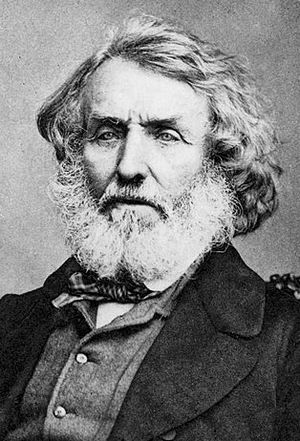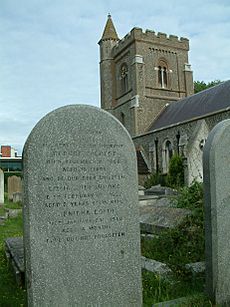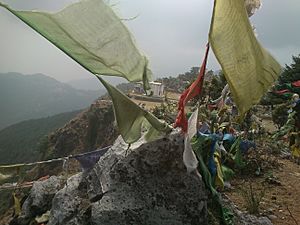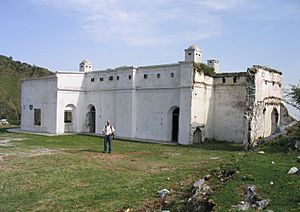George Everest facts for kids
Quick facts for kids
George Everest
|
|
|---|---|
 |
|
| Born | 4 July 1790 Crickhowell, Wales, or Greenwich, England
|
| Died | 1 December 1866 (aged 76) London, England
|
| Known for | Great Trigonometric Survey of India Being the eponym of Mount Everest |
| Awards | Medal of the Royal Astronomical Society (1847) |
| Scientific career | |
| Fields | Geography |
| Influences | William Lambton Thomas Colby |
| Influenced | Andrew Scott Waugh Radhanath Sikdar |
Sir George Everest (born July 4, 1790 – died December 1, 1866) was a British surveyor and geographer. He is famous for his work in India. From 1830 to 1843, he was the Surveyor General of India.
Everest received a military education and joined the East India Company when he was 16. He traveled to India to begin his career. He became an assistant to William Lambton on the Great Trigonometric Survey. This was a huge project to map India. In 1823, he took over from Lambton as the leader of the survey.
George Everest was key in mapping a long line from the south of India up to Nepal. This line, called a meridian arc, was about 2,400 kilometers (1,500 miles) long. This massive task took many years, from 1806 to 1841. He became Surveyor General of India in 1830. He retired in 1843 and went back to England.
In 1865, the Royal Geographical Society named the world's highest peak Mount Everest in his honor. This mountain had only recently been identified as the tallest. Andrew Scott Waugh, who worked under Everest and later took his place, suggested the name in 1856. Everest's name was chosen because it was hard to pick one local name for the mountain. He didn't want the mountain named after him. He felt he had not discovered it. He also thought his name was hard to write or say in Hindi.
Contents
Who Was George Everest?

George Everest was born on July 4, 1790. We are not completely sure where he was born. He was baptized in Greenwich, London, in January 1791. He might have been born in Greenwich or at his family's home, Gwernvale Manor, in Wales.
George was the oldest son and third of six children. His parents were Lucetta Mary and William Tristram Everest. His father was a lawyer and a local judge. The Everest family had lived in Greenwich for a long time. They were successful enough to buy a large estate in south Wales.
Everest's Education and Early Career
Everest studied at the Royal Military College in Marlow, Buckinghamshire. After his studies, he joined the East India Company in 1806. He became a second lieutenant in the Bengal Artillery. He sailed to India in the same year.
Not much is known about his first years in India. However, he was very good at math and astronomy. In 1814, he was sent to Java. There, he helped survey the island. He returned to Bengal in 1816. He helped improve maps of the Ganges and Hooghly rivers. He also surveyed a semaphore line from Calcutta to Benares. This line was about 400 kilometers (250 miles) long.
Everest's excellent work caught the eye of Colonel William Lambton. Lambton was leading the Great Trigonometrical Survey (GTS). He chose Everest as his main assistant. Everest joined Lambton in Hyderabad in 1818. They were mapping a meridian arc north from Cape Commorin. Everest did a lot of the fieldwork himself. In 1820, he got malaria and had to recover in South Africa.
Leading the Great Trigonometrical Survey
Everest came back to India in 1821. When Lambton died in 1823, Everest became the superintendent of the GTS. Over the next few years, he continued Lambton's work. He extended the meridian arc up to Sironj in central India.
Everest often had poor health. Fevers and joint pain left him partly paralyzed. He went to England in 1825 to get better. He stayed there for five years. During this time, he became a Fellow of the Royal Society in 1827. He also worked to get better equipment for the survey. He learned about surveying methods used in England.
In June 1830, Everest returned to India. He continued his work on the GTS. At the same time, he was named Surveyor General of India. The long arc from Cape Commorin to the northern border of British India was finished in 1841. This was done under the guidance of Andrew Scott Waugh.
Everest spent much of his time managing the survey. He also had to deal with criticism from England. He resigned in November 1842. He officially left his position in December 1843 and went back to England.
Later Life and Achievements
In 1845, Everest was a passenger on the first trip of the SS Great Britain. This was the first time a ship powered by a screw propeller crossed an ocean.
In 1847, Everest published a book about his measurements in India. For this work, he received a medal from the Royal Astronomical Society. He also became a member of the Royal Asiatic Society and the Royal Geographical Society.
Everest was promoted to colonel in 1854. He was made a Commander of the Order of the Bath in 1861. He was also given the title of Knight Bachelor in 1861. Sir George Everest passed away at his home in London on December 1, 1866. He was buried in St Andrew's Church, Hove, near Brighton.
How Mount Everest Got Its Name
George Everest never saw the mountain that now carries his name. He had no direct connection to it. However, he was important because he hired Andrew Scott Waugh. Waugh made the first official observations of the mountain. Everest also hired Radhanath Sikdar, who calculated the mountain's height.
Before its importance was known, the mountain was called Peak "B" and later Peak XV. In March 1856, Waugh wrote to the Royal Geographical Society. He announced that the mountain was likely the highest in the world. He suggested naming it "after my illustrious predecessor" (George Everest). He said there was "no local name that we can discover." Nepal was closed to the British at the time.
There were actually several local names for the mountain among the Nepalese and Tibetans. But British explorers could not enter those areas. People living south of the Himalayas did not have a specific name for the peak. For about ten years after 1856, Waugh's idea was discussed. Other experts suggested native names they thought were correct.
Everest himself did not want the mountain named after him. He felt that people in India would find his name hard to say and write in Hindi. Despite his objections, the society officially chose "Mount Everest" as the name in 1865.
Sir George Everest's House in India
George Everest owned a house in Mussoorie, India, for about 11 years. He bought it without seeing it first. Today, the house is mostly in ruins, but its roof is still there. There have been plans to turn it into a museum.
The house was built in 1832. It is known as Sir George Everest's House and Laboratory, or Park House. It is located about 6 kilometers (3.7 miles) west of Mussoorie's main market. From the house, you can see amazing views. On one side is the Doon Valley. On the other side are the Aglar River valley and the Himalayan Range to the north.

The house is managed by the Tourism Department. There are deep, uncovered water tanks in the front yard. These might have been for storing ice. They are now filled with trash and can be dangerous.
The inside of the house is empty. However, the fireplaces, roof, and door and window frames are still there. Steel bars secure the house, so you cannot go inside. Now that the house is more well-known and the road to it has improved, its walls often get covered in graffiti. They are then painted clean again.
New fences, tree planting, and a ticket booth were added around 2015. This suggests that there will be a fee to enter the property in the future. Inside, there are signs of renovations from several years ago. For example, there are ceramic floor tiles in the kitchen and electrical boxes. Architects are hoping to work on restoring this historic site.
Images for kids
See also
 In Spanish: George Everest para niños
In Spanish: George Everest para niños



